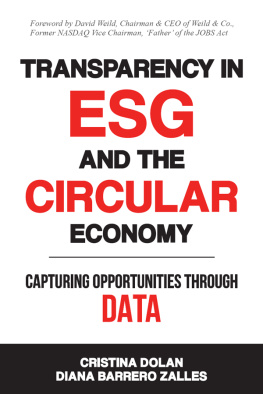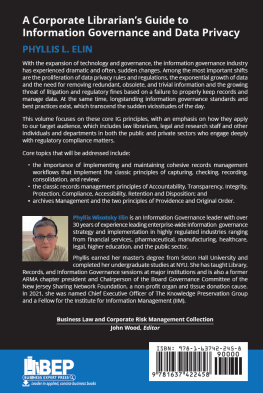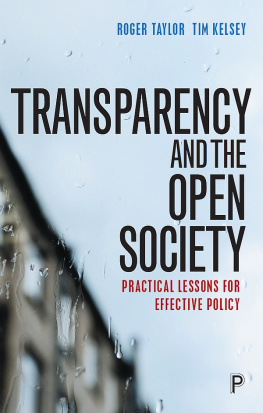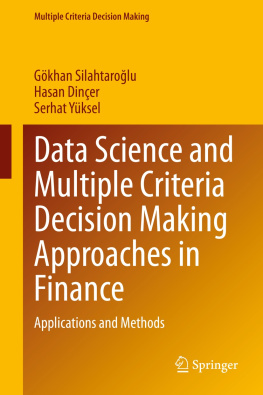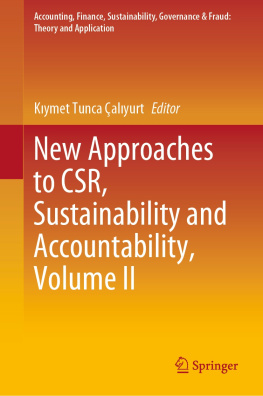Transparency in ESG and the Circular Economy
Transparency in ESG and the Circular Economy
Capturing Opportunities Through Data
Cristina Dolan and Diana Barrero Zalles

Transparency in ESG and the Circular Economy: Capturing Opportunities Through Data
Copyright Business Expert Press, LLC, 2022.
Cover design by Andrew_studio | Fiverr
Illustrations 2022 Cristina Dolan and Diana Barrero Zalles
Interior design by Exeter Premedia Services Private Ltd., Chennai, India
All rights reserved. No part of this publication may be reproduced, stored in a retrieval system, or transmitted in any form or by any meanselectronic, mechanical, photocopy, recording, or any other except for brief quotations, not to exceed 400 words, without the prior permission of the publisher.
First published in 2021 by
Business Expert Press, LLC
222 East 46th Street, New York, NY 10017
www.businessexpertpress.com
ISBN-13: 978-1-63742-153-6 (paperback)
ISBN-13: 978-1-63742-154-3 (e-book)
Business Expert Press Economics and Public Policy Collection
Collection ISSN: 2163-761X (print)
Collection ISSN: 2163-7628 (electronic)
First edition: 2021
10 9 8 7 6 5 4 3 2 1
As the world continues to transform at an accelerated pace, I dedicate this book to my sons, Teddy and Cristiaan Fitzsimons, who will be inheriting a very different world. Thank you both for always inspiring me, and as the Dr. Seuss quote from the Lorax states, Its not about what it is, its about what it can become. Never stop believing in your ability to make dreams come true!
Cristina
To all those who helped make this book possible and who believed in me along the journey. Your encouragement and support mean the world!
Diana
Description
This book is not a how to manual to propose yet another ESG framework. It focuses on the what and the why of the matter, in order to remove ambiguities, and presents the role of emerging technologies to manage ESG data and provide better understanding through transparency and accountability. It takes the perspective of a company seeking to attract ESG investments and become compliant with ESG regulatory requirements. It proposes the following main points:
Understanding ESG: ESG is a very broad topic that companies can implement adequately by integrating it into their existing strategic business operations. This requires buy-in at the governance level, integration across the corporate culture, and a long-term view.
Disregarding ESG Means Risk: Companies are experiencing pressure from several fronts to improve their ESG practices and reduce material financial risks. Today cybersecurity is particularly relevant.
Inconsistent Metrics & Lack of Clarity: Different approaches can rate the same company very differently. This can allow for inaccurate reporting such as greenwashing. It is also difficult to form a holistic view of the full ESG impact of an activity. For instance, an operation or product may be climate friendly, but the supply chain may create emissions, and management may be oblivious to labor standards.
Technology to Organize Data: In order to make changes, it is crucial to understand and measure the underlying problems. IoT can capture various data points. Distributed ledgers can record data and connect the various facets of ESG impact, capturing journeys of data to provide a holistic view. AI and Machine Learning can draw insights for improvement and iteration. While a convergence of frameworks can ensure breadth of data across major issues, we also need a level of granularity to allow investment approaches focused on specific topics.
What Companies can do to be ESG-Investable & ESG-Compliant: Regulations are ramping up ESG requirements, and public companies are rolling up the data and numbers. Large companies are requiring small suppliers and young tech partners to commit to their corporate sustainability practices. Looking ahead, trends toward ESG practices can support a new generation of sustainability native startups.
Keywords
ESG; environmental social governance; sustainability; UN sustainable development goals; cybersecurity; data security; circular economy; ESG data; climate tech; sustainable funds; sustainable investment; ESG standards; greenwashing
Contents
ESG may not be a new concept but its necessary for todays economy. This book does a tremendous job laying out the history of ESG, why its vitally important for investors and citizens today, and most importantly, how to measure it. This book fills in the required gap of outlining how to effectively and fairly measure ESG, doing so from a data driven and transparency perspective that is not only unique but unparalleled in its depth, intelligence and awareness of the impact that ESG can have in our world going forward.Jack Tatar, co-author of Cryptoassets: The Innovative Investors Guide to Bitcoin and Beyond
A very important and timely book that explains the evolution of the ESG data landscape and its relevance for decision making. An amazingly comprehensive analysis of how sustainable investing is evolving, this book explains with great clarity what matters for professionals and decision makers. As sustainability is reshaping the world of finance, this book offers a timely and highly relevant overview of trends and insights professionals and decision makers need to know.Georg Kell, Chairman of the Board at Arabesque, Founding Director of the United Nations Global Compact
ESG attempts to redefine and expand the definition of a corporate stakeholder. Releasing an expanded view on opportunities, challenges, rewards and consequences. This book provides a much needed holistic view of how the disparate attempts to codify a cohesive and mainstream framework are gaining momentum but still in the early stages.Rich Radice, CFO, Moven Bank
Humanity sits at the convergence of two massively transformative trends that urgently demand a cohesive, collective response. The first is the rapid expansion of interconnected digital technologies and in the data they generate. The second is the rapid progression of climate change and the threat it poses to societies. To say, the first should be marshaled to address the second goes without saying. The challenge is to put all that digital data and computing capacity into a common ESG framework that produces consistent, coordinated actions by companies and investors, even as they face competing interests and operate in independent jurisdictions. In this vital, timely book, the authors produce a clear-headed manual for achieving that, one that cuts through all the acronyms and confusing taxonomy to point to a path forward.Michael Casey, Chief Content Officer, CoinDesk, co-author of The Truth Machine: the Blockchain and the Future of Everything
Trust is critical in the transforming world economy, shaped by new business models built on next generation technologies that enable unprecedented connectivity across a wide range of stakeholders across the globe. Yet how do we uphold good business practices consistently, particularly when it comes to data privacy and security, when often, standards are fragmented across sectors and geographies? Stakeholders remain on different islands, subject to vastly different metrics and approaches to data. This critical book brings light to the role of emerging technologies to consolidate data and maximize the benefits of understanding such data better, which is fundamental for implementing sustainable operations, spanning from all aspects of governance, environmental, and social practices, for the new class of businesses that will shape the future.

